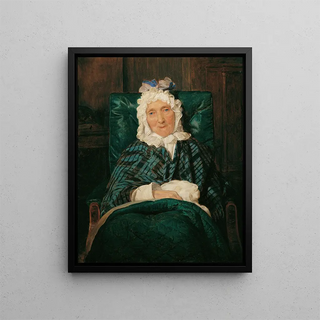Painting Aloisia Eltz in an armchair - Ferdinand Georg Waldmüller | Art print


View from behind

Frame (optional)
In the rich and diverse universe of 19th-century art, the work of Ferdinand Georg Waldmüller stands out for its ability to capture the very essence of its subjects. The art print Aloisia Eltz dans un fauteuil - Ferdinand Georg Waldmüller is a shining example of this mastery. This painting, depicting the peaceful beauty of Aloisia Eltz, evokes an atmosphere that is both intimate and elegant, inviting the viewer to immerse themselves in a moment suspended in time. The composition, both simple and refined, transports us to a bourgeois salon of yesteryear, where every detail seems to tell a story. The posture of the model, her contemplative gaze, and the softness of the colors make this work a true artistic jewel.
Style and uniqueness of the work
Waldmüller, an Austrian painter, is recognized for his unique style that combines realism and romanticism. In Aloisia Eltz dans un fauteuil, he manages to create an atmosphere of serenity and contemplation. The gentle light bathing the scene accentuates the delicate features of the young woman, while the choice of colors, ranging from pastel tones to more subdued shades, confers emotional depth to the piece. Every element of the painting, from the richly decorated armchair to the drapes of Aloisia’s dress, is carefully thought out to reflect not only the external beauty of his model but also a certain introspection. Waldmüller excels in representing textures, making the fabric of the armchair and the softness of the young woman’s skin almost palpable. This meticulous attention to detail and light creates an image that transcends a simple portrait to become a true study of character.
The artist and his influence
Ferdinand Georg Waldmüller, born in 1793, marked his era with his innovative artistic vision and his commitment to accessible realism. As a central figure of the realist movement in Austria, he influenced many contemporary and future artists. Waldmüller does not merely reproduce scenes from everyday life; he seeks to capture the soul of his subjects, to immortalize them in their authenticity. His humanist approach to art, where each

Matte finish

View from behind

Frame (optional)
In the rich and diverse universe of 19th-century art, the work of Ferdinand Georg Waldmüller stands out for its ability to capture the very essence of its subjects. The art print Aloisia Eltz dans un fauteuil - Ferdinand Georg Waldmüller is a shining example of this mastery. This painting, depicting the peaceful beauty of Aloisia Eltz, evokes an atmosphere that is both intimate and elegant, inviting the viewer to immerse themselves in a moment suspended in time. The composition, both simple and refined, transports us to a bourgeois salon of yesteryear, where every detail seems to tell a story. The posture of the model, her contemplative gaze, and the softness of the colors make this work a true artistic jewel.
Style and uniqueness of the work
Waldmüller, an Austrian painter, is recognized for his unique style that combines realism and romanticism. In Aloisia Eltz dans un fauteuil, he manages to create an atmosphere of serenity and contemplation. The gentle light bathing the scene accentuates the delicate features of the young woman, while the choice of colors, ranging from pastel tones to more subdued shades, confers emotional depth to the piece. Every element of the painting, from the richly decorated armchair to the drapes of Aloisia’s dress, is carefully thought out to reflect not only the external beauty of his model but also a certain introspection. Waldmüller excels in representing textures, making the fabric of the armchair and the softness of the young woman’s skin almost palpable. This meticulous attention to detail and light creates an image that transcends a simple portrait to become a true study of character.
The artist and his influence
Ferdinand Georg Waldmüller, born in 1793, marked his era with his innovative artistic vision and his commitment to accessible realism. As a central figure of the realist movement in Austria, he influenced many contemporary and future artists. Waldmüller does not merely reproduce scenes from everyday life; he seeks to capture the soul of his subjects, to immortalize them in their authenticity. His humanist approach to art, where each
12,34 €






